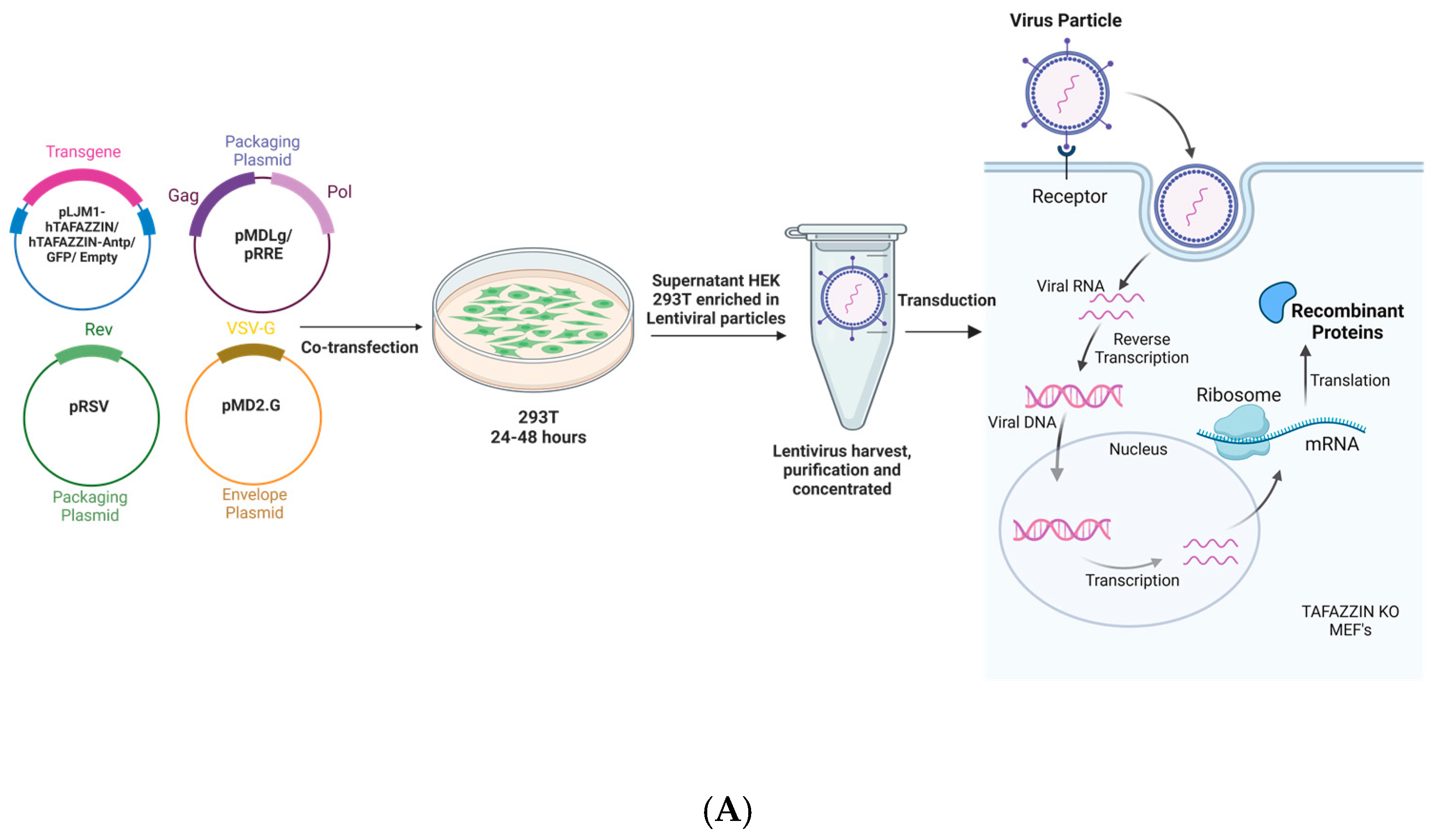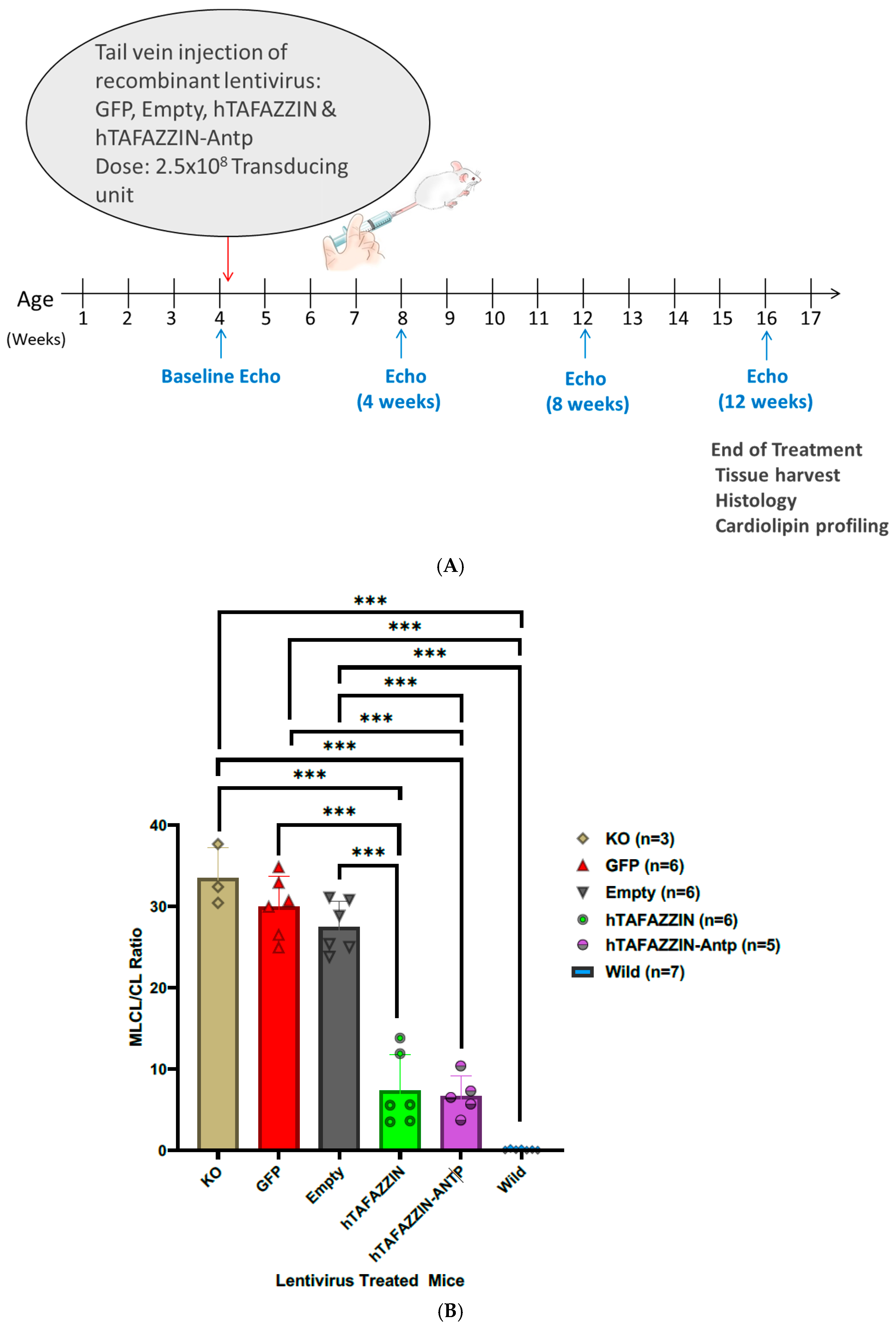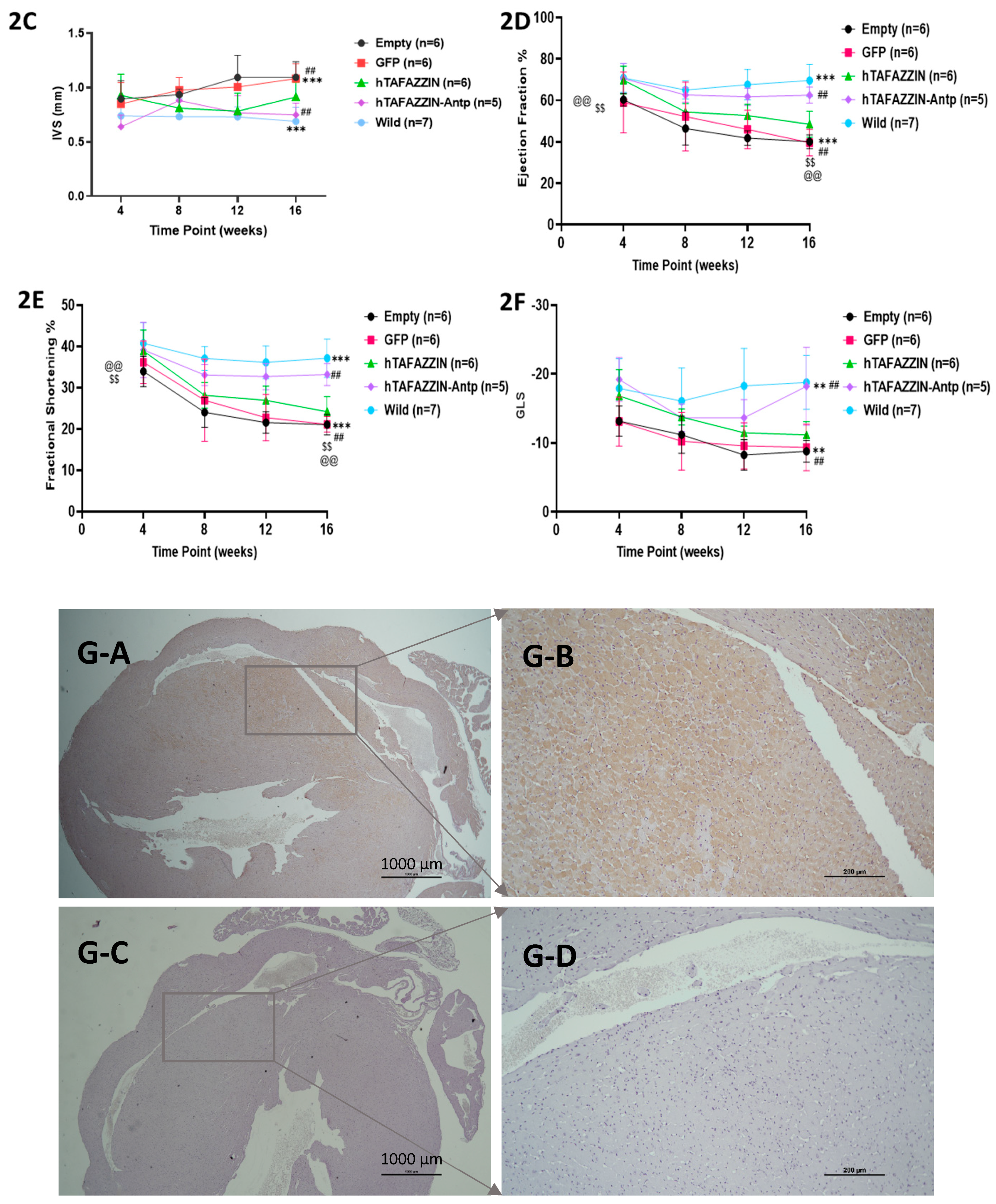Cell-Penetrating Peptide Enhances Tafazzin Gene Therapy in Mouse Model of Barth Syndrome
Abstract
1. Introduction
2. Results and Discussion
3. Materials and Methods
3.1. Generation of Lentiviruses
3.2. Infection of TAFAZZIN KO MEF Cells and Assessment of MLCL/CL Ratio
3.3. Assessment of TAFAZZIN Gene Therapy in TAFAZZIN KO Mice
3.4. Immunohistochemistry of Lentivirally Infected Mouse Hearts
3.5. Assesment of MLCL/CL Ratio in Excised Mouse Heart Mitochondria by Mass Spectrometry
3.6. Statistical Methods
Author Contributions
Funding
Institutional Review Board Statement
Informed Consent Statement
Data Availability Statement
Conflicts of Interest
References
- Chin, M.T.; Conway, S.J. Role of Tafazzin in Mitochondrial Function, Development and Disease. J. Dev. Biol. 2020, 8, 10. [Google Scholar] [CrossRef] [PubMed]
- Thompson, R.; Jefferies, J.; Wang, S.; Pu, W.T.; Takemoto, C.; Hornby, B.; Heyman, A.; Chin, M.T.; Vernon, H.J. Current and future treatment approaches for Barth syndrome. J. Inherit. Metab. Dis. 2022, 45, 17–28. [Google Scholar] [CrossRef] [PubMed]
- Suzuki-Hatano, S.; Saha, M.; Rizzo, S.A.; Witko, R.L.; Gosiker, B.J.; Ramanathan, M.; Soustek, M.S.; Jones, M.D.; Kang, P.B.; Byrne, B.J.; et al. AAV-Mediated TAZ Gene Replacement Restores Mitochondrial and Cardioskeletal Function in Barth Syndrome. Hum. Gene Ther. 2019, 30, 139–154. [Google Scholar] [CrossRef] [PubMed]
- Suzuki-Hatano, S.; Sriramvenugopal, M.; Ramanathan, M.; Soustek, M.; Byrne, B.J.; Cade, W.T.; Kang, P.B.; Pacak, C.A. Increased mtDNA Abundance and Improved Function in Human Barth Syndrome Patient Fibroblasts Following AAV-TAZ Gene Delivery. Int. J. Mol. Sci. 2019, 20, 3416. [Google Scholar] [CrossRef]
- Wang, S.; Li, Y.; Xu, Y.; Ma, Q.; Lin, Z.; Schlame, M.; Bezzerides, V.J.; Strathdee, D.; Pu, W.T. AAV Gene Therapy Prevents and Reverses Heart Failure in a Murine Knockout Model of Barth Syndrome. Circ. Res. 2020, 126, 1024–1039. [Google Scholar] [CrossRef]
- Dinca, A.; Chien, W.M.; Chin, M.T. Intracellular Delivery of Proteins with Cell-Penetrating Peptides for Therapeutic Uses in Human Disease. Int. J. Mol. Sci. 2016, 17, 263. [Google Scholar] [CrossRef] [PubMed]
- Higuchi, K.; Yoshimitsu, M.; Fan, X.; Guo, X.; Rasaiah, V.I.; Yen, J.; Tei, C.; Takenaka, T.; Medin, J.A. Alpha-galactosidase A-Tat fusion enhances storage reduction in hearts and kidneys of Fabry mice. Mol. Med. 2010, 16, 216–221. [Google Scholar] [CrossRef]
- Min, S.H.; Kim, D.M.; Kim, M.N.; Ge, J.; Lee, D.C.; Park, I.Y.; Park, K.C.; Hwang, J.S.; Cho, C.W.; Yeom, Y.I. Gene delivery using a derivative of the protein transduction domain peptide, K-Antp. Biomaterials 2010, 31, 1858–1864. [Google Scholar] [CrossRef] [PubMed]
- Baile, M.G.; Sathappa, M.; Lu, Y.W.; Pryce, E.; Whited, K.; McCaffery, J.M.; Han, X.; Alder, N.N.; Claypool, S.M. Unremodeled and remodeled cardiolipin are functionally indistinguishable in yeast. J. Biol. Chem. 2014, 289, 1768–1778. [Google Scholar] [CrossRef] [PubMed]
- Perera, G.; Power, L.; Larson, A.; Codden, C.J.; Awata, J.; Batorsky, R.; Strathdee, D.; Chin, M.T. Single Cell Transcriptomic Analysis in a Mouse Model of Barth Syndrome Reveals Cell-Specific Alterations in Gene Expression and Intercellular Communication. Int. J. Mol. Sci. 2023, 24, 11594. [Google Scholar] [CrossRef]
- Chou, C.; Martin, G.L.; Perera, G.; Awata, J.; Larson, A.; Blanton, R.; Chin, M.T. A novel alphaB-crystallin R123W variant drives hypertrophic cardiomyopathy by promoting maladaptive calcium-dependent signal transduction. Front. Cardiovasc. Med. 2023, 10, 1223244. [Google Scholar] [CrossRef] [PubMed]
- Sancak, Y.; Peterson, T.R.; Shaul, Y.D.; Lindquist, R.A.; Thoreen, C.C.; Bar-Peled, L.; Sabatini, D.M. The Rag GTPases bind raptor and mediate amino acid signaling to mTORC1. Science 2008, 320, 1496–1501. [Google Scholar] [CrossRef] [PubMed]
- Durkin, M.E.; Qian, X.; Popescu, N.C.; Lowy, D.R. Isolation of Mouse Embryo Fibroblasts. Bio Protoc. 2013, 3, e908. [Google Scholar] [CrossRef]
- Houtkooper, R.H.; Rodenburg, R.J.; Thiels, C.; van Lenthe, H.; Stet, F.; Poll-The, B.T.; Stone, J.E.; Steward, C.G.; Wanders, R.J.; Smeitink, J.; et al. Cardiolipin and monolysocardiolipin analysis in fibroblasts, lymphocytes, and tissues using high-performance liquid chromatography-mass spectrometry as a diagnostic test for Barth syndrome. Anal. Biochem. 2009, 387, 230–237. [Google Scholar] [CrossRef]
- Kulik, W.; van Lenthe, H.; Stet, F.S.; Houtkooper, R.H.; Kemp, H.; Stone, J.E.; Steward, C.G.; Wanders, R.J.; Vaz, F.M. Bloodspot assay using HPLC-tandem mass spectrometry for detection of Barth syndrome. Clin. Chem. 2008, 54, 371–378. [Google Scholar] [CrossRef] [PubMed]




Disclaimer/Publisher’s Note: The statements, opinions and data contained in all publications are solely those of the individual author(s) and contributor(s) and not of MDPI and/or the editor(s). MDPI and/or the editor(s) disclaim responsibility for any injury to people or property resulting from any ideas, methods, instructions or products referred to in the content. |
© 2024 by the authors. Licensee MDPI, Basel, Switzerland. This article is an open access article distributed under the terms and conditions of the Creative Commons Attribution (CC BY) license (https://creativecommons.org/licenses/by/4.0/).
Share and Cite
Raghav, R.; Awata, J.; Martin, G.L.; Strathdee, D.; Blanton, R.M.; Chin, M.T. Cell-Penetrating Peptide Enhances Tafazzin Gene Therapy in Mouse Model of Barth Syndrome. Int. J. Mol. Sci. 2024, 25, 13560. https://doi.org/10.3390/ijms252413560
Raghav R, Awata J, Martin GL, Strathdee D, Blanton RM, Chin MT. Cell-Penetrating Peptide Enhances Tafazzin Gene Therapy in Mouse Model of Barth Syndrome. International Journal of Molecular Sciences. 2024; 25(24):13560. https://doi.org/10.3390/ijms252413560
Chicago/Turabian StyleRaghav, Rahul, Junya Awata, Gregory L. Martin, Douglas Strathdee, Robert M. Blanton, and Michael T. Chin. 2024. "Cell-Penetrating Peptide Enhances Tafazzin Gene Therapy in Mouse Model of Barth Syndrome" International Journal of Molecular Sciences 25, no. 24: 13560. https://doi.org/10.3390/ijms252413560
APA StyleRaghav, R., Awata, J., Martin, G. L., Strathdee, D., Blanton, R. M., & Chin, M. T. (2024). Cell-Penetrating Peptide Enhances Tafazzin Gene Therapy in Mouse Model of Barth Syndrome. International Journal of Molecular Sciences, 25(24), 13560. https://doi.org/10.3390/ijms252413560







